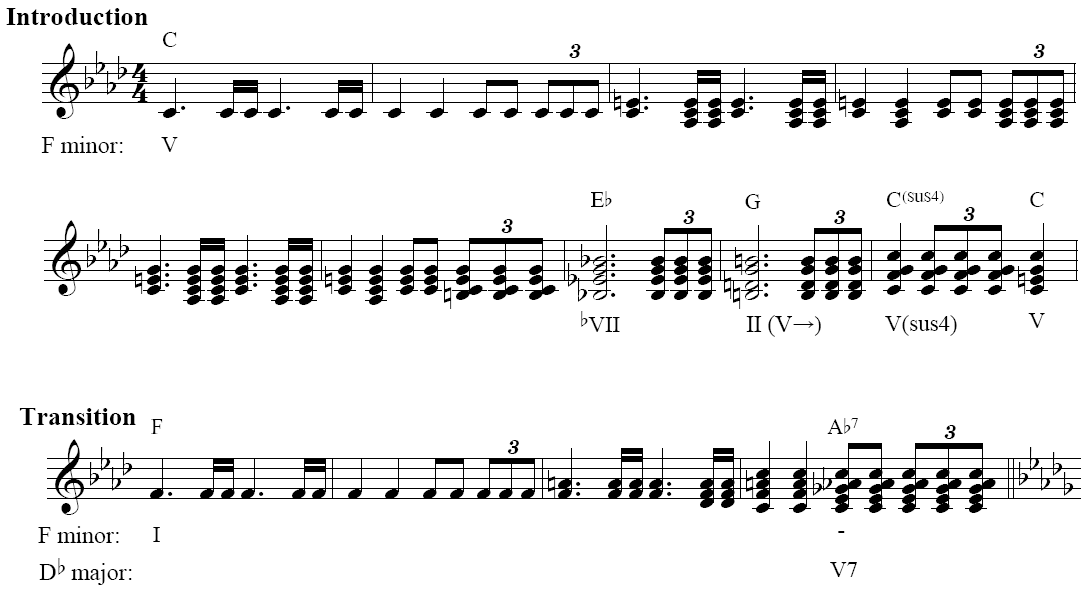|
"The Throne Room", which concludes A New Hope, shares significant structural similarities with American marches (a la John Philip Sousa). Marches typically follow a six-part formal layout: Introduction - brief, fanfare-ish, and often in unison until a cadence at the end 1st Strain - the first melody, repeated immediately 2nd Strain - the second melody, builds slightly in intensity, repeated immediately Trio - a section of repose (lower intensity), key change of +1 flat Dogfight - intense and harmonically unstable section, to be resolved by the... Grandioso - the climax, often repeats back to the trio/dogfight the first time Of course, not every march follows this structure exactly, but this is the basic template. Let's use perhaps the most famous march ever composed as an example: "The Stars and Stripes Forever" by John Philip Sousa. 0:03-0:08 Introduction 0:08-0:23 1st strain 0:23-0:38 1st strain, repeated 0:38-0:54 2nd strain 0:54-1:10 2nd strain, repeated 1:10-1:40 Trio 1:40-2:04 Dogfight 2:04-2:35 Grandioso 2:35-2:58 Dogfight, repeated 2:58-3:30 Grandioso, repeated Now compare that with the formal design of "The Throne Room". 0:00-0:17 Introduction - C major 0:18-0:34 1st strain (Force theme) - F minor 0:34-0:48 1st strain repeat (add trombones) - F minor 0:48-0:56 Transition (based on the introduction, but a perfect fifth lower pitched) 0:56-1:12 Trio - D-flat major 1:12-1:29 Main theme, part b - D-flat major 1:29-1:46 Grandioso - D-flat major "The Throne Room" uses a very simplified version of the march structure, but it is clearly related. Both share opening fanfares that start in unison, a repeated first strain, a transition to a trio with a key change of one added flat, and conclude with a grandioso. That being said, of course, there are also obvious dissimilarities. "The Throne Room" omits the 2nd strain entirely, along with the dogfight. Instead, the 1st strain and trio are separated by a transition based on the music of the introduction; and the trio and grandioso are separated by the secondary part of main theme, the melody of which is then repeated as the grandioso. That transition from 1st strain to trio (which in terms of structural function replaces the 2nd strain) is worth a close look. The first two measures of the transition are identical to the first two measures of the introduction except for the fact that the transition is based on F while the intro is based on C. The transition then abbreviates the introductory fanfare by jumping straight to a secondary dominant (A-flat 7 functions as a V7 of D-flat) in the fourth measure, which functions both harmonically and structurally as the impetus for the traditional key change of one added flat at the trio. In other words, both the intro and the transition conclude with dominants requiring resolution, but in different keys. Although much of "The Throne Room" follows traditional march tonal designs, one aspect that is somewhat unconventional is the fact that the first half is in minor. The majority of marches are in major the entire time (with the possible exception of the dog fight). Even so, there are some notable precedents, perhaps the most famous being Sousa's "The Gladiator March". Lastly, although the term "character" is far more subjective than tonality and structure, there are several other marches that share similarities with "The Throne Room" in terms of character - that dignified, noble, heroic quality that makes "The Throne Room" such effective music at the conclusion of A New Hope. Sir William Walton's "Crown Imperial March" (the name of which would obviously influence John Williams' score to The Empire Strikes Back) is perhaps the most obvious such example. (Notice how the very first notes are remarkably similar to the secondary main Star Wars theme, as heard in "The Throne Room".) Another such example of similarity in musical character is "Orb and Sceptre" by the same composer. (Note how it opens with a trumpet fanfare, quite similar to "The Throne Room".) To summarize, then, John Williams' "The Throne Room" combines elements of formal and tonal designs of American marches (as seen most notably in John Philip Sousa) with the majestic and regal character of English marches (as heard most notably in Edward Elgar and Sir William Walton).
0 Comments
Leave a Reply. |
The Music of Star WarsThese posts will help focus and develop my analyses of John Williams' film scores. Archives
December 2019
Categories
All
|

 RSS Feed
RSS Feed
